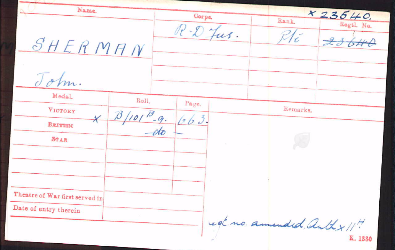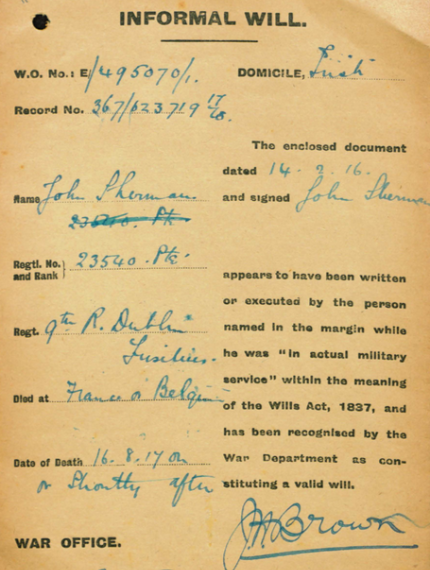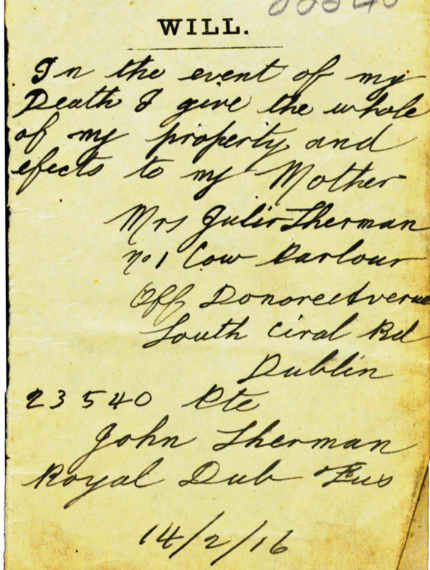About Me
During a free trial on Ancestry searching through family records, I discovered my grandmother had some very interesting uncles. Two of my great-grand uncles, Mortimer and Timothy McCarthy, from Kinsale, travelled with Ernest Shackleton on two seperate missions of Antartic exploration. Timothy then went on to join the Royal Navy during World War One and was killed when his ship was torpedoed in the Western Approaches on March 16th 1917. Their brother John, also joined the 2nd Cantebury Regiment and was killed in the Battle of the Somme on September 20th 1916. This was when my interest in the First World war became so important to me because I now had a personal connection.
It was in December 2016 that my history teacher, Mr. Foley, came to me and asked if I would like to write an essay to be in with the chance of researching a soldier and visiting their grave in the Ypres region of Belgium. I jumped at the chance and was delighted when I heard I had been given a place on the trip the following month.
It was not just my familial connection to the war that made me so interested in the project, but the idea behind it. No matter the timeframe, the war, the winners, there is always the little people involved. Most of the time these are statistics. I however, now had the opportunity to bring history to life, find the names of these soldiers and tell their story.
History, in my eyes, is like a cycle. It is so prone to repeating itself, and only through learning from our mistakes and correcting history, can we be smarter than it. Now, we can all have the chance to break the vicious cycle.
First Meeting in Collins Barracks
Going into Collins Barracks on Saturday, February 4th, I had no idea what to expect. I was on my way to find out who my soldier was, meet the organisers of the project and most importantly, the other students I would be spending four days with in Belgium. Nervous would have been an understatement...

My nerves were settled as soon as I got in and met the teachers and other students. Everyone was so nice and I could not have asked for a better first experience. Getting my soldier's name put me straight into work mode and I was so anxious to find out everything possible about this man.
Research
After leaving the meeting, I wanted to get straight into my research. I used several online researches such as Ancestry.co.uk, FindMyPast, Forces War Records, and Irish Genealogy.
However I got some amazing help off some amazing people. I would like to say a special thank you to Conor Dodd, resident historian in Glasnevin Cemetery, along with resident genealogist Lynn Brady, the Genealogy Department in the National Library of Ireland on Kildare Street, and the librarians in the Reading Room in Pearse Street Library. Without these people, I would not have been able to bring proper closure to John's story and tell his story.
Second Meeting in Collins Barracks
Coming back to Collins Barracks felt like a completely different world. I had my research on my soldier completed, I had gotten to know some of the students through our group chat and talking to them through Snapchat, and I was no longer nervous. I was honoured to have been asked to present a PowerPoint on my soldier. For the first time, people would hear John's story. I was marking the beginning of getting his name out to the masses.
Now that I was getting to see other people's work and research, I was in genuine awe at the passion and commitment everyone in the room had towards the project. It was May and Belgium was only one short month away.
Belgium
Day One in Belgium
Arriving in Dublin Airport on Tuesday June 24th was the culmination of this trip. The beginning of the end. My ambitions of going to John's grave were about to come true. I was going to a country I had never been in before, with people I didn't know. Under any other circumstances you might find such an experience daunting. Under mine, it was exciting.
On our first full day in Belgium we were taken around the historic Belgian town of Leuven. After our short tour we met the German students. It was great to finally put the names to the faces and meet such an integral part of the trip. I thought it was a amazing to have the German's view added into the trip because we would both be getting the other side of the war's perspective. As G.K Chesterton once said "The true soldier fights not because he hates what is in front of him, but because he loves what is behind him.", and we would be able to see through to this.
Day Two in Belgium
Looking back, our second day feels like a blur! We visited so many amazing places and I made so many memories.

The second day included us travelling to so many memorable places, such as the Island of Island Peace Park, and the Pool of Peace where fifty thousand German soldiers were killed when the British set off landmines under their trenches.




The Pool of Peace is now a series of lakes where people come to commemorate huge German casualties.

"Trust is hard to come by. That's why I keep my circle small and tight" ~ Eminem
One of the most memorable parts of the trip in my eyes had to be Bayernwald German Trenches, which were carefully restored to resemble German trenches from 1916. It was so heart wrenching to walk through history. Trench warfare is something I had only ever read about, but I could not help remember walking through these trenches, that soldiers my own age who walked through these trenches to their deaths. The last lines of Wilfred Owen's Dulce Et Decorum Est were all that came to mind:
"My friend, you would not tell with such high zest,
To children ardent for some desperate glory,
The old Lie" Dulce est decorum est
Pro patria mori"


One of the most evocative moments of the trip came when visiting the Death Cells in Poperinge. Seeing the post where Commonwealth soldiers were shot at dawn for desertion and cowardice was such a haunting image to remind us all of the dark nature of war. As Josh's soldier was also shot here, I thought it was quite an emotional journey and something I will never forget. You can read more about this in Josh's archive.

Day Three in Belgium
Day Three brought some incredible highlights of the trip. It was phenomenal to visit the two German cemeteries and see the comparison to the Commonwealth Graves. Us Irish students were so emotional during our visit to Vladsto German Cemetery. An experience I will never forget was when a group of us Irish students walked around to clean leaves and twigs off the headstones of the German soldiers. We felt that it was important as they to not have the same funding as the Commonwealth Graves Commission have to keep their graveyards as well kept as they are.
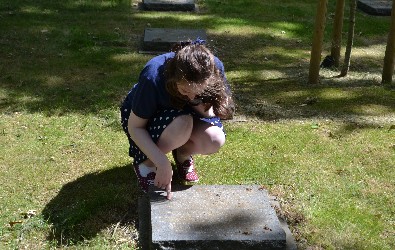
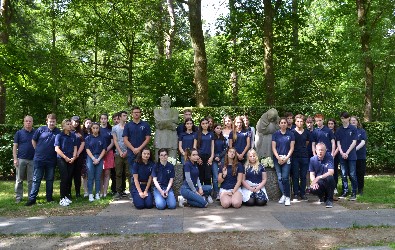
On that Friday, June 23rd, I got to visit my soldier, Private John Sherman's grave. John's final resting place is in Poelcappelle British Cemetery.
To say it was an honour to research this man is an understatement. It was as if through my months of research that I came to know John as if he were a distant friend. I was the first person, to my knowledge, to go to his grave. I brought soil from the grave of his mother, father, two brothers and niece that died in infancy to place on his grave as a piece of home. I would like to think that in doing so, I could bring John's story to a close, as in a way, he was finally reunited with the family he left in Dublin. Just shy of the centenary of his death, a part of home would be able to come to see him off. It was a truly wonderful and sorrowful experience. When I set out researching John's life, my one goal was to go to his final place of rest and tell his story. I did. And I could not be happier I got to sit at his graveside.


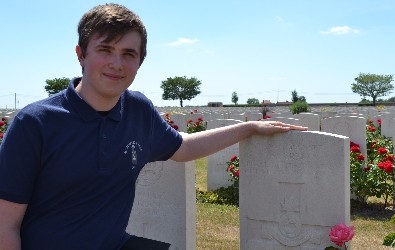

Memorial Wall in Tyne Cot Cemetery.

Tyne Cot is the largest Commonwealth War Cemetery.

A mass grave in Langemark German Cemetery.
I was so fortunate to go to the Menin Gate with Ciara, to experience it myself before the Last Post Ceremony and be there with her for such an emotional experience of seeing her great-grand uncle's name on the walls of the Menin Gate. It was such a shock to see so many names covering every inch of the Menin Gate and served as a stark reminder of the futility of war. I would highly advise you read Ciara's archive for a better insight.

We then attended the Last Post Ceremony, where Ciara and Yassin laid a wreath to remember all the soldiers that lost their lives so that people in their countries may live to see a better day, without war. Gerry Moore, the organiser of the trip, also read the Exhortation, taken from Laurence Binyon's For the Fallen.
The Final Day
There was not a dry eye as we set off to return to Dublin Airport. Following a bus ride from Leuven to Amsterdam and a flight home, we all said our teary goodbyes as we went our separate ways on June 24th.

I had an amazing four days in Belgium, with the most wonderful people, which I will truly never forget.


Dead Men Rising
He is long dead,
His nation does not know his name,
He died for them.
Some live in arrogance,
Consumed by hostility,
Is this what they wanted?
Is this what he wanted?
He died for them,
For us.
The War to End All Wars.
They went to war for us!
For their country!
So that we wouldn't have to.
Yet we live on,
Ignorance is bliss,
And they lie in Belgian fields,
Dead.
Forgotten.
But there is some,
Who will always remember them,
Whom pay their respects,
Weep at their graves,
Their stories live on,
Through us.
Heed their message,
Learn the lessons of our past,
Or history will repeat itself,
And crush us all.
Fear not soldiers of yesteryear!
You did not die in vain,
You died so we would live to see a better day.
Shane Macken

My Adopted Friend
The time has come,
I am finally here,
To say my first hello, and final goodbye.
As I walk through their white rows,
Their echoes whisper throughout the world,
I hear their gratitude,
Someone has finally come to see them home.
I find his grave,
Never touched by another hand,
I don't know what to do,
How do I justify this man's life?
How do I pay the respects of a family that never said goodbye?
I carry my soil,
A heavy burden, for I, I am the first, and the last, to see him off.
This soil is home,
This soil was a life,
Long gone.
Long forgotten.
Yet here it is.
Here I am.
Standing under the Belgian sun,
A life of pain, a life of war,
And I have come to bid farewell.
Sleep tight, for you,
You are in a place of peace,
You are at eternal rest.
Shane Macken
When I put my name forward for this trip last year, I did not know what impact it would have on me. Looking back on four wonderful days, I am delighted to say that this trip would be one of the defining moments in my life. I saw so much, learnt so much and got to tell the story of a man whose name was left to rot in the vaults of time. But most importantly, I made some amazing friends. There are simply no words to express the outrageous love I have for the people I met on the trip. I would like to thank Gerry and the entire team from the bottom of my heart for this amazing opportunity. I cannot express the gratitude I have for Eileen Magnier and Brian McVeigh from RTÉ for travelling with us to document this trip and giving us all an amazing "Nationwide" documentary we will always cherish. I guess you could say Summer 2017 was unforgettable!












